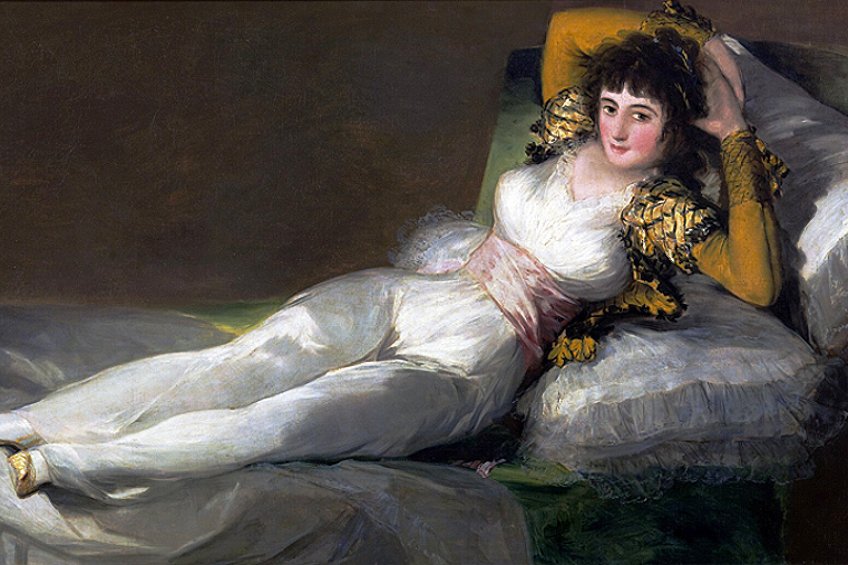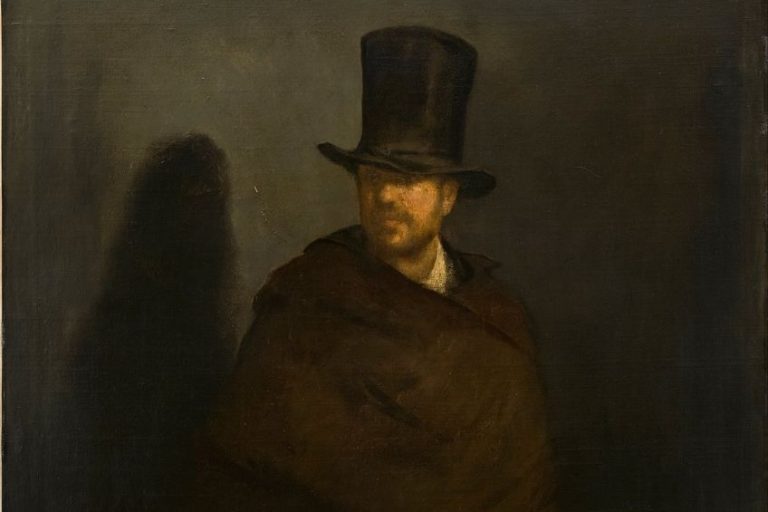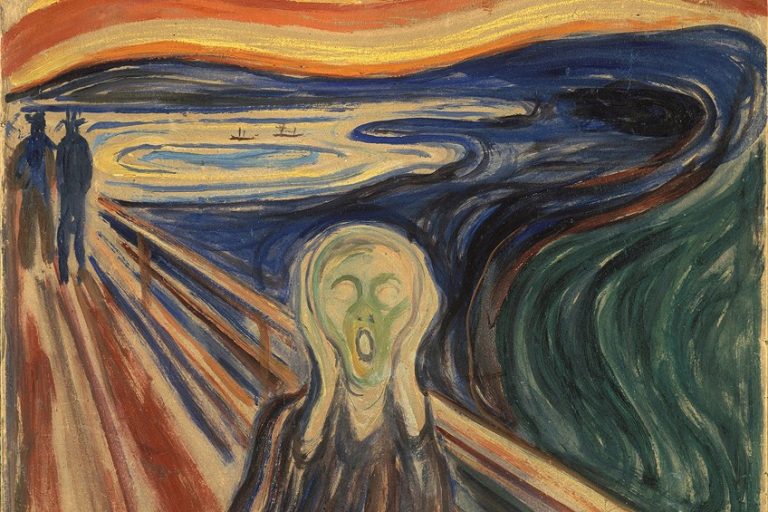10 Francisco Goya Paintings – The Dark and the Divine
Francisco Goya, one of Spain’s most celebrated artists, left an indelible mark on the art world with his masterful and often provocative paintings. Born in 1746 in Fuendetodos, Spain, Goya’s work spanned various genres, from portraiture to historical scenes, showcasing his exceptional talent and keen eye for social commentary. His paintings are known for their striking realism, emotional depth, and exploration of themes such as war, politics, and the human condition. In this article, we delve into Goya’s legacy by exploring the top 10 most famous paintings that continue to captivate audiences worldwide.
Table of Contents
- 1 The Impact of Francisco Goya
- 2 Top 10 Most Famous Francisco Goya Paintings to Know
- 2.1 The Nude Maja (c. 1797 – 1800)
- 2.2 Witches’ Flight (1798)
- 2.3 The Sleep of Reason Produces Monsters (c. 1799)
- 2.4 Charles IV of Spain and His Family (1800 – 1801)
- 2.5 The Clothed Maja (c. 1800 – 1803)
- 2.6 The Second of May 1808 (1814)
- 2.7 The Third of May 1808 (1814)
- 2.8 Saturn Devouring His Son (c. 1819 – 1823)
- 2.9 The Dog (c. 1819 – 1823)
- 2.10 Witches’ Sabbath (c. 1819 – 1823)
- 3 Frequently Asked Questions
The Impact of Francisco Goya
Francisco Goya’s impact on art and culture is profound and far-reaching. As one of the most influential painters of his time, Goya challenged traditional artistic conventions and paved the way for modern art movements. His fearless exploration of social and political themes, such as war, injustice, and human suffering, gave voice to the marginalized and sparked critical discourse. Goya’s innovative techniques, including his use of chiaroscuro and expressive brushwork, revolutionized the way artists approached composition and storytelling in their work.

Beyond his artistic contributions, Goya’s legacy extends to his role as a cultural commentator and visionary. His keen observations of society’s ills, captured with raw emotion and unflinching honesty, continue to resonate with audiences today. Goya’s influence can be seen in the works of subsequent generations of artists who were inspired by his boldness, versatility, and unwavering commitment to artistic integrity.
Top 10 Most Famous Francisco Goya Paintings to Know
In this section, we delve into Francisco Goya’s top 10 artworks, each offering a unique perspective on the artist’s genius and the tumultuous times in which he lived. From poignant depictions of war and political upheaval to haunting explorations of myth, madness, and human nature, Goya’s paintings continue to captivate and provoke thought centuries after their creation.
Join us on a journey through Goya’s masterpieces, where each artwork tells a compelling story and reveals the depth of his artistic vision and impact on the art world.
The Nude Maja (c. 1797 – 1800)
| Date | c. 1797 – 1800 |
| Medium | Oil on canvas |
| Dimensions (cm) | 98 × 191 |
| Where Is It Housed? | Museo del Prado, Madrid, Spain |
Goya’s The Nude Maja is a groundbreaking work that challenges the societal norms of its time. Depicting a reclining nude woman with unabashed realism and sensuality, the painting sparked controversy due to its explicitness. However, its significance lies in Goya’s defiance of censorship and his bold exploration of human form and desire, setting a precedent for later artists to challenge conventional ideals of beauty and sexuality.

Witches’ Flight (1798)
| Date | 1798 |
| Medium | Oil on canvas |
| Dimensions (cm) | 43 × 30 |
| Where Is It Housed? | Museo Lázaro Galdiano, Madrid, Spain |
Witches’ Flight portrays a surreal and fantastical scene of witches soaring through the night sky on broomsticks. This painting delves into themes of folklore, superstition, and the supernatural, reflecting Goya’s fascination with the macabre and mysterious.
Its importance lies in its contribution to the Romantic movement’s interest in the darker aspects of human imagination and the unknown.

The Sleep of Reason Produces Monsters (c. 1799)
| Date | c. 1799 |
| Medium | Etching |
| Dimensions (cm) | 21.5 × 15.5 |
| Where Is It Housed? | Various collections |
In The Sleep of Reason Produces Monsters, Goya presents a powerful allegorical image of a man asleep amidst looming creatures of darkness. This work is emblematic of Goya’s exploration of reason, imagination, and the human psyche. It serves as a cautionary reminder of the dangers of ignorance and the consequences of succumbing to irrational fears and anxieties.

Charles IV of Spain and His Family (1800 – 1801)
| Date | 1800 – 1801 |
| Medium | Oil on canvas |
| Dimensions (cm) | 280 × 336 |
| Where Is It Housed? | Museo del Prado, Madrid, Spain |
This grand portrait captures the Spanish royal family in a formal and regal manner, showcasing Goya’s mastery of portraiture. The painting’s importance lies in its historical significance as a representation of royal power and authority during Goya’s time. It also reflects Goya’s skill in capturing the nuances of expression and personality, even within a formal group setting.

The Clothed Maja (c. 1800 – 1803)
| Date | c. 1800 – 1803 |
| Medium | Oil on canvas |
| Dimensions (cm) | 98 × 191 |
| Where Is It Housed? | Museo del Prado, Madrid, Spain |
The Clothed Maja is a companion piece to The Nude Maja, depicting the same woman now clothed in a white mantilla and gown. This painting exemplifies Goya’s ability to portray the same subject in contrasting states, from naked vulnerability to clothed dignity.
Its significance lies in its dual representation of femininity, inviting viewers to contemplate societal perceptions of modesty and eroticism.

The Second of May 1808 (1814)
| Date | 1814 |
| Medium | Oil on canvas |
| Dimensions (cm) | 266 × 345 |
| Where Is It Housed? | Museo del Prado, Madrid, Spain |
Goya’s The Second of May 1808 depicts the brutal reprisals by French soldiers against Spanish civilians during the Dos de Mayo Uprising in Madrid. The painting captures the chaos and violence of the event, with defiant civilians facing the onslaught of the military. Its importance lies in its historical documentation of a pivotal moment in Spanish history and Goya’s skill in portraying raw emotion and human resilience in the face of oppression.

The Third of May 1808 (1814)
| Date | 1814 |
| Medium | Oil on canvas |
| Dimensions (cm) | 266 × 345 |
| Where Is It Housed? | Museo del Prado, Madrid, Spain |
In The Third of May 1808, Goya depicts the execution of Spanish rebels by French soldiers during the Peninsular War. This painting is a poignant portrayal of the horrors of war and the sacrifice of ordinary people for their ideals. Its significance lies in its emotional impact and Goya’s use of light and shadow to convey the drama and tragedy of the scene, making it a powerful anti-war statement.

Saturn Devouring His Son (c. 1819 – 1823)
| Date | c. 1819 – 1823 |
| Medium | Oil on canvas |
| Dimensions (cm) | 143 × 81 |
| Where Is It Housed? | Museo del Prado, Madrid, Spain |
Saturn Devouring His Son is part of Goya’s Black Paintings series, exploring themes of mortality, madness, and human suffering. The painting portrays the mythological Titan Saturn consuming one of his children, reflecting Goya’s own dark and introspective period.
Its importance lies in its psychological depth and the artist’s use of myth to confront universal themes of destruction and mortality.
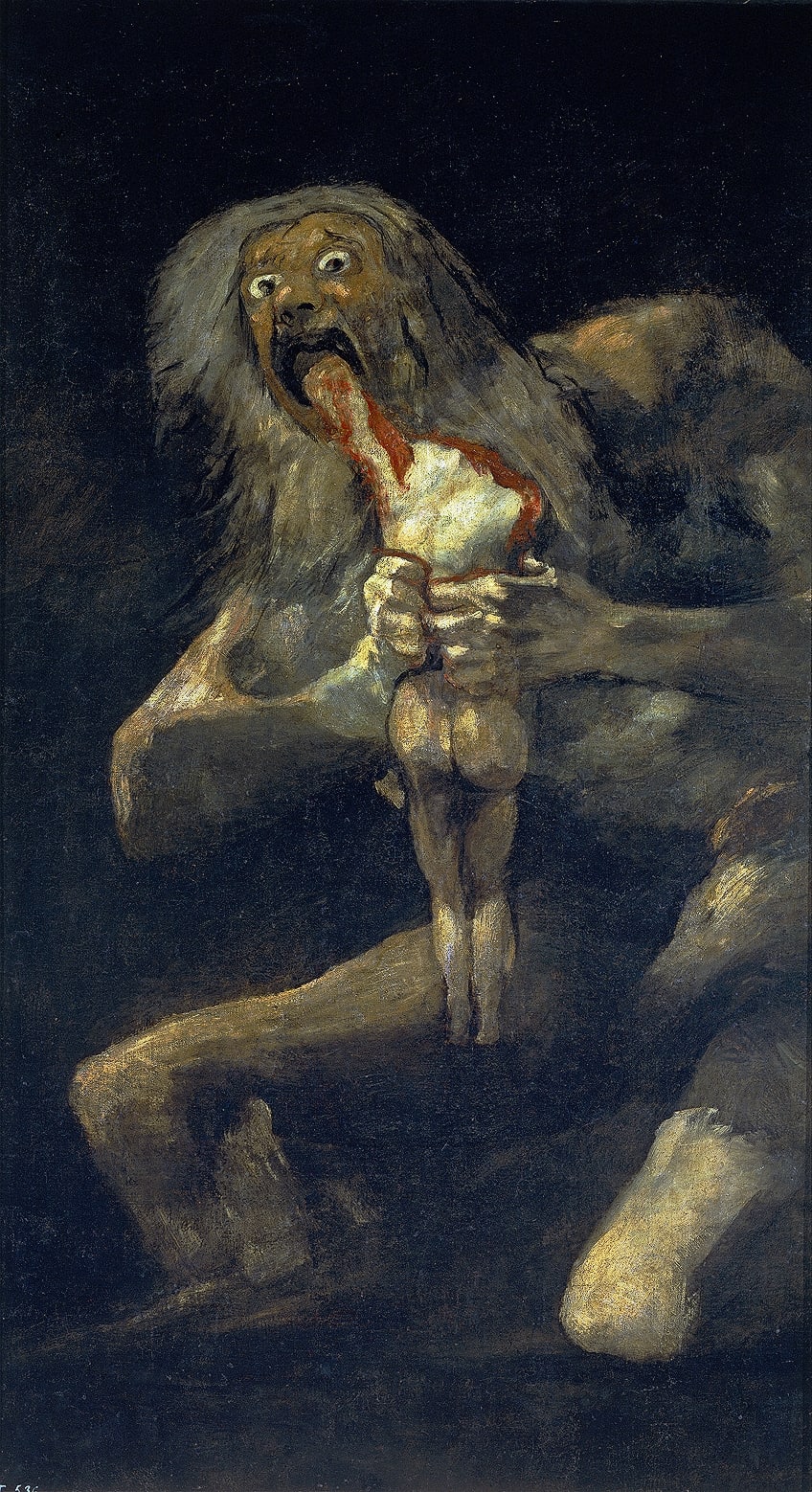
The Dog (c. 1819 – 1823)
| Date | c. 1819 – 1823 |
| Medium | Oil on canvas |
| Dimensions (cm) | 131.5 × 79 |
| Where Is It Housed? | Museo del Prado, Madrid, Spain |
Goya’s The Dog is a haunting and enigmatic work depicting a lone dog adrift in a vast, desolate landscape. The painting’s subject matter is open to interpretation, symbolizing themes of isolation, despair, and existential angst. Its importance lies in its ability to evoke a sense of profound solitude and uncertainty, inviting viewers to contemplate the human condition and the fleeting nature of life.
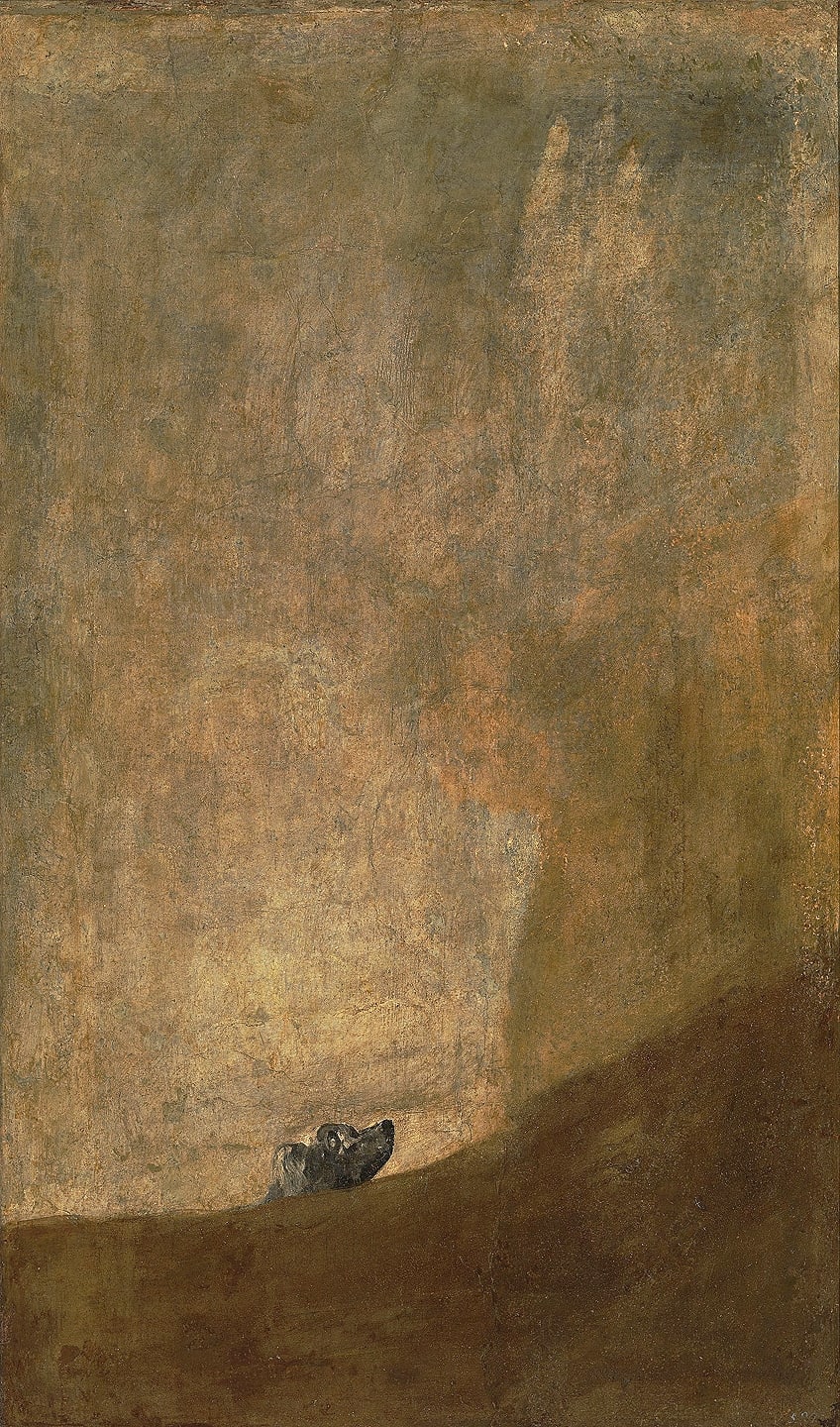
Witches’ Sabbath (c. 1819 – 1823)
| Date | c. 1819 – 1823 |
| Medium | Oil on canvas |
| Dimensions (cm) | 43.5 × 30.5 |
| Where Is It Housed? | Museo Lázaro Galdiano, Madrid, Spain |
Witches’ Sabbath is also part of Goya’s Black Paintings series, depicting a dark and eerie scene of witches gathered around a cauldron. The painting delves into themes of witchcraft, superstition, and the supernatural, reflecting Goya’s fascination with the macabre and the unknown. Its importance lies in its exploration of human fears and the blurred boundaries between reality and fantasy, capturing the imagination with its haunting imagery.

As we draw to the end of our article, Francisco Goya’s top 10 most famous paintings offer a profound insight into the breadth and depth of his artistic genius. From the hauntingly evocative The Third of May 1808 to the enigmatic and surreal Saturn Devouring His Son, Goya’s works transcend time, sparking contemplation, emotion, and dialogue about human nature, society, and the complexities of existence. Through his bold brushstrokes, poignant themes, and unwavering dedication to artistic expression, Goya continues to inspire and captivate audiences, solidifying his legacy as one of the greatest painters in art history.
Frequently Asked Questions
What Inspired Francisco Goya’s Dark and Introspective Black Paintings Series?
Francisco Goya’s Black Paintings series was inspired by personal struggles, including his deteriorating health, political disillusionment, and the horrors of war. These paintings delve into themes of mortality, madness, isolation, and human suffering, reflecting Goya’s own psychological turmoil during that period.
How Did Francisco Goya’s Paintings Reflect the Social and Political Climate of His Time?
Francisco Goya’s paintings often served as poignant reflections of the turbulent social and political landscape in 18th and 19th century Spain. His works, such as The Second of May 1808 and The Third of May 1808, captured the atrocities of war and the resilience of ordinary people facing oppression.
What Is the Significance of Francisco Goya’s Portrayal of Mythological Themes in His Paintings?
Francisco Goya’s exploration of mythological themes, such as in Saturn Devouring His Son and Witches’ Sabbath, added layers of symbolism and allegory to his art. These paintings delve into universal themes of destruction, mortality, superstition, and the darker aspects of human nature, inviting viewers to contemplate deeper meanings beyond the literal imagery.
Isabella studied at the University of Cape Town in South Africa and graduated with a Bachelor of Arts majoring in English Literature & Language and Psychology. Throughout her undergraduate years, she took Art History as an additional subject and absolutely loved it. Building on from her art history knowledge that began in high school, art has always been a particular area of fascination for her. From learning about artworks previously unknown to her, or sharpening her existing understanding of specific works, the ability to continue learning within this interesting sphere excites her greatly.
Her focal points of interest in art history encompass profiling specific artists and art movements, as it is these areas where she is able to really dig deep into the rich narrative of the art world. Additionally, she particularly enjoys exploring the different artistic styles of the 20th century, as well as the important impact that female artists have had on the development of art history.
Learn more about Isabella Meyer and the Art in Context Team.
Cite this Article
Isabella, Meyer, “10 Francisco Goya Paintings – The Dark and the Divine.” Art in Context. March 26, 2024. URL: https://artincontext.org/10-francisco-goya-paintings/
Meyer, I. (2024, 26 March). 10 Francisco Goya Paintings – The Dark and the Divine. Art in Context. https://artincontext.org/10-francisco-goya-paintings/
Meyer, Isabella. “10 Francisco Goya Paintings – The Dark and the Divine.” Art in Context, March 26, 2024. https://artincontext.org/10-francisco-goya-paintings/.


